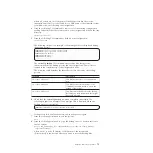
You must copy these files to a location outside of your system because the
/tmp
directory on this node becomes inaccessible if the configuration node changes.
The configuration node might change in response to an error recovery action or
to a user maintenance activity.
Tip:
To maintain controlled access to your configuration data, copy the backup
files to a location that is password-protected.
9.
Ensure that the copies of the backup files are stored in the location that you
specified in step 8 on page 73.
You can rename the backup files to include the configuration node name either at
the start or end of the file names so that you can easily identify these files when
you are ready to restore your configuration.
Issue the following command to rename the backup files that are stored on a Linux
or IBM AIX
®
host:
mv /
offclusterstorage
/svc.config.backup.xml
/
offclusterstorage
/svc.config.backup.xml_
myconfignode
where
offclusterstorage
is the name of the directory where the backup files are
stored and
myconfignode
is the name of your configuration node.
To rename the backup files that are stored on a Windows host, right-click the name
of the file and select
Rename
.
Restoring the system configuration
Use this procedure in the following situations: only if the recover procedure has
failed or if the data that is stored on the volumes is not required. For directions on
the recover procedure, see “Recover system procedure” on page 65.
This configuration restore procedure is designed to restore information about your
configuration, such as volumes, local Metro Mirror information, local Global Mirror
information, storage pools, and nodes. All the data that you have written to the
volumes is not restored. To restore the data on the volumes, you must restore
application data from any application that uses the volumes on the clustered
system as storage separately. Therefore, you must have a backup of this data before
you follow the configuration recovery process.
You must regularly back up your configuration data and your application data to
avoid data loss. If a system is lost after a severe failure occurs, both configuration
for the system and application data is lost. You must reinstate the system to the
exact state it was in before the failure, and then recover the application data.
Important:
There are two phases during the restore process: prepare and execute.
You must not change the fabric or system between these two phases.
If you do not understand the instructions to run the CLI commands, see the
command-line interface reference information.
To restore your configuration data, follow these steps:
1.
Verify that all nodes are available as candidate nodes before you run this
recovery procedure. You must remove errors 550 or 578 to put the node in
candidate state. For all nodes that display these errors, perform the following
steps:
74
Storwize V7000: Troubleshooting, Recovery, and Maintenance Guide
Содержание Storwize V7000
Страница 1: ...IBM Storwize V7000 Version 6 3 0 Troubleshooting Recovery and Maintenance Guide GC27 2291 02...
Страница 6: ...vi Storwize V7000 Troubleshooting Recovery and Maintenance Guide...
Страница 8: ...viii Storwize V7000 Troubleshooting Recovery and Maintenance Guide...
Страница 10: ...x Storwize V7000 Troubleshooting Recovery and Maintenance Guide...
Страница 34: ...18 Storwize V7000 Troubleshooting Recovery and Maintenance Guide...
Страница 42: ...26 Storwize V7000 Troubleshooting Recovery and Maintenance Guide...
Страница 80: ...64 Storwize V7000 Troubleshooting Recovery and Maintenance Guide...
Страница 128: ...112 Storwize V7000 Troubleshooting Recovery and Maintenance Guide...
Страница 156: ...140 Storwize V7000 Troubleshooting Recovery and Maintenance Guide...
Страница 166: ...150 Storwize V7000 Troubleshooting Recovery and Maintenance Guide...
Страница 171: ......
Страница 172: ...Printed in USA GC27 2291 02...






























